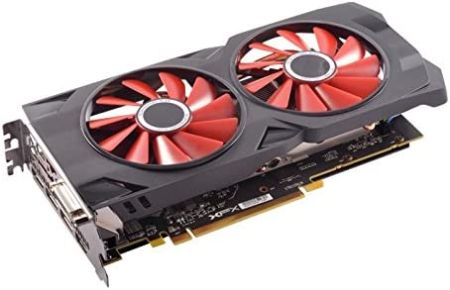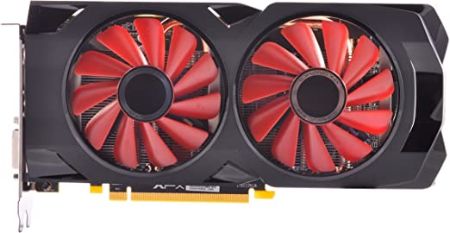At the point when a great many people see illustration cards to purchase for their impending apparatuses, they are normally checking out the Titans of the world: the GTX 1080 ti or the Rx Vega 64…or well, a Titan XP.
Notwithstanding, there is a part of the gaming people who doesn’t precisely require, or for sure needs the vast power two of those previously mentioned cards hold, yet rather needs something they can play the most recent titles are quality framerates and designs choices. Or on the other hand, we’re discussing the gamer who perhaps can’t buy a 1080 ti yet needs to play their #1 games on PC.
The XFX Rx 570 RS 8GB Black Edition packs a remarkable punch, and it does as such in a smoothed-out structure factor. This is the main AMD card I’ve at any point utilized (returning to my old 7950 HD days) that necessary just 1 8-pin connector for power. But that solitary 8-pin connector is sufficient to keep the two enormous fans on the GPU itself, which loans well to keeping the Rx 570 cool.
Overview
Furthermore, that is something critical in my brain, since the last hardly any AMD cards I’ve utilized they’ve been heatsinks themselves, not saving cool enough for me to feel open to overclocking. However utilizing MSI Afterburner, the XFX gives sufficient headroom to easily overclock but still keep up with incredible temperatures.
The benchmarks shown are at the stock clocks to give the most perfect outcomes, however, the card is prepared to do the significant length of gaming with a moderate increment (I pushed the clock past 1400MHz without any issues) to the clock speeds. It is fascinating to see likewise the leaps in execution from the 570 to the 580 and, surprisingly, the Rx Vega 64 while looking at the three across a similar test framework.
I likewise gave benchmarks for the GTX 1080 for an examination with Nvidia’s contributions and keeping in mind that it’s promptly evident that 1080, out of the container is an all the more remarkable card, it’s most certainly fascinating to see the presentation contrast and can assist somebody with pursuing the choice regarding whether that additional expense legitimizes the exhibition jump for them.
Cost
RX 570‘s current $175 retail cost it is somewhat of a deal. Truly, overclocked SKUs like this Sapphire card will cost more, however, a 4GB standard RX 570 will in any case convey brilliant 1080p gaming execution and offer you a decent chance and some good 1440p edge rates as well.
RX 570 Specs
Again we’re discussing Polaris Enhanced. It’s not AMD presenting to us an alternate age of Polaris GPUs, however seriously requires a year of learnings from assembling both the design cards and the Polaris silicon itself. That implies we have a more developed GPU regardless of whether it is still basically precisely the same by and large plan as we saw with the underlying 400-series cards.
However, what does that truly make a difference to us? A more developed creation interaction will mean there ought to be more noteworthy yields from the genuine wafers and in this manner all the more completely utilitarian GPUs being brought into the world from them. That offers AMD the chance to push them undeniably harder than they did with the 400-series cards, which is the reason both the RX 580 and this RX 570 have sent off with reference clocks far higher than their begetters. Also, why the RX 590, with its 12nm chip, can be driven significantly further.

As far as the power AMD is permitting somewhat more squeeze through the Polaris 20 GPU inside the RX 570. In light of the greater clock speeds, it currently draws more power and is evaluated with a 150W warm plan point (TDP) rather than the RX 470’s 120W TDP. The main other genuine change is in the memory framework.
The RX 570 still comes in both 4GB and 8GB trims, yet the reference tickers for the GDDR5 memory presently start at 7GHz, giving the new card a higher pinnacle memory transfer speed score than the RX 470. The 500-series card runs at 224GB/s while the 400-series variation is appraised at 211GB/s.
Remains of the Singularity
The Radeon RX 570 pulls close by to GeForce GTX 1060 3GB, which beforehand would have posted higher benchmark results than Radeon RX 470 under Ashes of the Singularity: Escalation’s Extreme detail setting at 1920×1080.
The two cards are somewhat slower than GeForce GTX 970, which was sent off back in 2014 for $330. It’s insane that an identical presentation sells for under $200 today.
As we progress through the benchmarks, watch out for GeForce GTX 1060 3GB comparable to the considerably less costly GeForce GTX 1050 Ti 4GB. Albeit 1060 beats it definitively in Ashes, that isn’t generally the situation.
Power Consumption
Like Radeon RX 580, AMD presented a moderate memory clock state so the GDDR5 doesn’t need to run at maximum speed with numerous screens connected or while playing back video content. Since your showcases are set to a similar goal, this approach works similarly too for Radeon RX 570.

With regards to gaming, however, the card breaks out and about. A 30 MHz-quicker GPU and a higher memory clock rate result in an extra 13W of force utilization. Our pressure test looks surprisingly more dreadful, maximizing the 200W power limit. These numbers show that Asus attempts to improve at balancing out its lift recurrence contrasted with last age’s adaptation by expanding the card’s power limit.
RX 570 4GB Performance
At the point when the RX 570 first came out, we were commending it for exactly how close the refreshed GPU was getting to the gaming execution of the past age’s RX 480. Be that as it may, presently the base has exited the mining market, and the RX 570 has turned into the best financial plan illustrations card, it’s practically more fascinating to take a gander at its nearest estimating rival, Nvidia’s GTX 1050 Ti.
That is a card that is still somewhat more costly than this noteworthy little Polaris GPU but is way, far behind on execution. On the off chance that the RX 570 draws near to RX 480 and RX 580 level execution, it crushes the nearest GeForce GPU to it.
- Slightly quicker than the Radeon RX 470
- Outstanding 1080p performance
- AMD keeps its price competitive.
- Ample RAM (4GB GDDR5) is advantageous
- More limited thermal solutions
- Little space for overclocking
- Disappointment induced by rebranding existing hardware
Furthermore, with that degree of execution, it additionally gets very near the GTX 1060 as well.
In a respectable number of games, the RX 570 will net you 60fps, or more, at the most noteworthy 1080p settings. It’s likewise not a terrible little card for 1440p, by the same token. Also, on the off chance that you drop your settings down to high or medium, you’ll get incredible 1440p gaming execution.
On the off chance that you are wearing a 1440p screen, 4GB is presumably going to appear to be very close in a year or somewhere in the vicinity, and on the off chance that you anticipate moving your sights towards a 4K future or VR venture then you will require a higher-spec card.
Conclusion
AMD’s Radeon RX 570 is a close copy of the RX 470 it replaces, besides somewhat higher clock rates. The organization knew its objective, no doubt: some additional exhibition is all it expected to close the hole with GeForce GTX 1060 3GB in games where Nvidia’s card was quicker.
The Radeon RX 570, similar to its ancestor, falls into a genuinely thick blend of proficient GPUs. Anybody with a not entirely set in stone to wrench up the detail settings in their number one games will go with a GeForce GTX 1060 6GB/Radeon RX 580 or higher.

Anybody playing at 1920×1080 and able to think twice about quality to set aside some cash can pull off a GeForce GTX 1050 Ti. Lovers who went overboard on a GeForce GTX 970 or Radeon R9 390 last age are as yet partaking in those cards and their capacity to slice through 1080p effortlessly.
Accordingly, Radeon RX 570 requests explicitly to people gunning for maximized subtleties at 1920×1080 who, for reasons unknown, didn’t as of now hop on Radeon RX 470. AMD’s information recommends that 500 million PC gamers use illustration cards over two years of age, 80% of which are Radeon R9 380X-class or slower. Along these lines, in principle, this card’s objective market is tremendous. We should check whether AMD can exploit its undisputed triumph, then.









